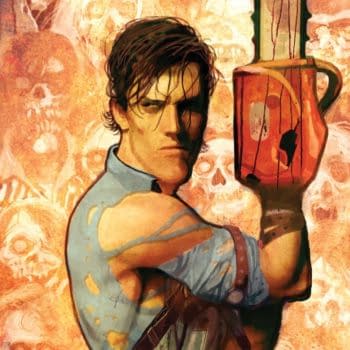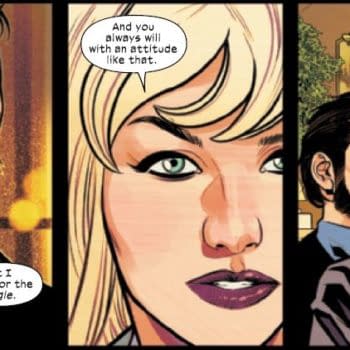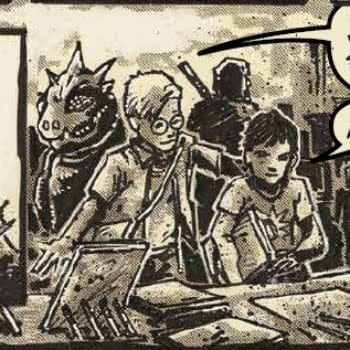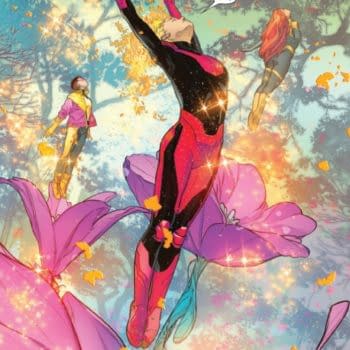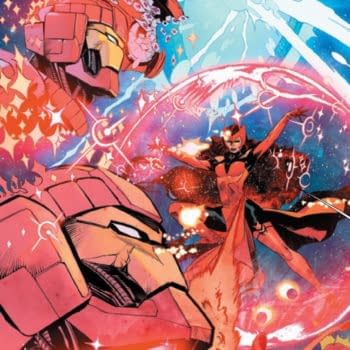Posted in: Comics | Tagged:
Gendercrunching February 2017 – At DC And Marvel, Women Predominantly Write Female Characters
By Tim Hanley
After topping Marvel's overall percentage of female creators for a lengthy run, a sizeable drop at DC has put them behind Marvel for the first time since September. We also check in on who's writing what at DC and Marvel to see how the work load breaks down for male and female writers.
DC COMICS
DC posted their lowest total for female creators in nearly a year with numbers that were well off their recent highs. In February 2017, DC put out 82 new comic books featuring 729 credited creators, 610 men and 79 women. Let's look at their stats:
The publisher's overall percentage of female creators fell 1.7% from January, not a massive tumble but certainly a noticeable decline after what had been a fairly steady run as of late. By category, there were several small gains inside the books, including upticks for female writers, pencillers, inkers, colorists, and letterers. Meanwhile, female editors slipped down slightly and both cover artists and assistant editors came in a couple of points below last month's totals. The losses outweighed the gains, leading to a low showing.
The Past Year at DC: While DC had been drifting down somewhat as of late, they were staying within the ballpark of their autumn highs until this month:
Now they're several points of that mark, and their recent declines look less like small fluctuations near their top end and more like early signs of a bit of a skid. Hopefully they can pull out of it in the months to come.
MARVEL COMICS
Marvel, on the other hand, saw some growth and may be levelling out at a slightly higher plateau than where they were last fall. In February 2017, Marvel released 91 comics from 811 creators, 672 men and 139 women. Here are their numbers:
An overall female creator percentage gain of 1% is a solid step for Marvel, which has been stuck below their recent highs for some time now. They're still a bit off that level, but it's an encouraging sign. Most of the changes by category were fairly minor; female cover artists and pencillers ticked up, writers and colorists and assistant editors ticked down, and inkers and letterers stayed the same. But female editors posted more noticeable gains, jumping up nearly 4% compared to January. All together, things shook out in a positive direction for female representation at Marvel.
The Past Year at Marvel: Marvel obviously remains below their previous highs, but their numbers through the winter are a bit higher than what we saw in the fall:
While the data is very up and down, it looks like Marvel might be slowly crawling upwards overall as of late in a two steps forward, one step back fashion. It will be interesting to see where they go next month.
WHO THE WRITERS ARE WRITING
Last February, we took a look at how the writing duties broke down by gender at DC and Marvel, and the results were stark. While male writers were writing both male and female characters, as well as team books, female writers were largely writing only female characters. Now that it's a year later, it's time to check back in and see if the numbers have changed.
In terms of methodology, we're just looking at the superhero books, so non-superhero licensed properties (mainly cartoons at DC and Star Wars at Marvel) and any Vertigo or Icon comics are out. We break each publisher's lineup into three categories: books with a male lead, books with a female lead, and team books. Then we separate the writers by gender and sort them into the appropriate categories to see who is writing what.
We'll start with DC Comics, just looking at their February 2017 numbers:
Each triad represents a different category of book, and DC as a whole is green, male writers are light blue, and female writers are light red. So, the numbers for male writers are fairly close to how DC's line looks as a whole, within a few percentage points of each other for each category of book. Men write male-led and team books at a slightly higher rate than DC's production numbers, and write female-led books at a slightly lower rate, but the numbers are very much in the same ballpark. In short, men are writing everyone.
Female writers, however, break down differently. They write male-led and team books at a rate far lower than DC's production numbers, and write female-led books at a much, much higher rate. In short, female writers are predominantly writing female characters.
Moreover, they're doing so at a higher level than last year, as we can see in this larger chart that's formatted slightly differently:
The green numbers are all of DC's superhero books, regardless of writer; last year is darker green, and this year is lighter (the dark/light system holds throughout). As you can see, things haven't changed a lot overall. Proportionally, there are slightly fewer male-led series and slightly more female-led series, but it's all quite similar to last year. Men are writing books at roughly the same rate as well, but there's a noticeable change for female writers: Women wrote female-led books 70% of the time last year, and that's risen to 85% now.
Let's take a look at Marvel's numbers as well, but we'll start with the bigger chart this time:
Marvel's production as a whole has changed a lot since last year. Team books are down considerably, with more solo books for male and female characters in the mix. The numbers for male writers have adjusted accordingly; men are writing more male-led and female-led books than last year, and fewer team books. And, just like with DC, the male output matches Marvel's larger output, as we can see with this chart showing just February 2017:
Again, men are writing everyone, at roughly the same rates that Marvel publishes their books.
For women, we can sort of see the changes in Marvel's output in the larger chart. Women are writing more male-led and female-led books, and are down to no team books at all. But turning to the second chart, the distribution remains very disproportionate. Marvel publishes 46% male-led books but only 11% of woman writers at Marvel are on a male-led book (also, it's just one book, Becky Cloonan on The Punisher). Meanwhile, Marvel publishes 26% female-led books, yet 89% of woman writers at Marvel are writing female-led books. Just like at DC, women are mainly writing women, again at a higher rate than last year.
Here's a raw number comparison to further underline the stark differences. At DC, 38 men are writing male-led books compared to 1 woman, while 12 men are writing female-led books compared to 11 women. At Marvel, 43 men are writing male-led books compared to 1 woman, while 16 men are writing female-led books compared to 8 women. At both publishers, there are more men writing women than women writing women, and writing women is about the only thing both publishers have women doing. This speaks to the lack of women writers at DC and Marvel generally; as our numbers show each month, men dominate the writing category. But it also shows how men get to write a broad range of characters, while women seem limited to women.
Now, part of this may be choice. Some female writers may be more interested in writing female characters, and that's cool. But 85-90% of them feeling that way seems a bit steep. Plus, their male counterparts are clearly interested in writing everyone, and they are doing so. It stands to reason that many female writers would be interested in writing everyone as well, but that doesn't seem to be an option at this time. Last year, we talked about how the next step in a more representative superhero industry was women writing a wider range of characters, not just female characters. A year later, we've actually taken a step back, with women writing more women. DC and Marvel need to broaden their horizons and get female writers on male-led books, just as they have a slew of male writers on female-led books. Good writers can write everyone, and there is an amazingly talented corps of female writers working at the Big Two right now. DC and Marvel would be wise to stop limiting them.
To learn more about this statistics project and its methodology click here, and to see the previous stats click here. You can visit Tim at Straitened Circumstances and follow him on Twitter @timhanley01. His books Wonder Woman Unbound and Investigating Lois Lane are available now, and his new book, The Many Lives of Catwoman: The Felonious History of a Feline Fatale, comes out July 1.















